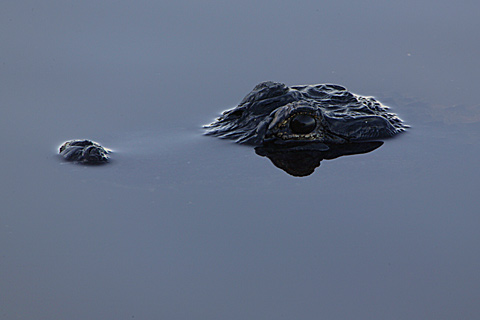
Found floating in an impoundment on the Black Point Wildlife Drive in the Merritt Island NWR, this one is just a baby - about 3 feet long.
|
Ken's Journal - Summer 2003
|
||
| Tuesday, 8/26/2003, Day 12. Made an early morning trip out to Merritt Island National Wildlife Refuge to see what kind of wildlife is active in the summer. Merritt Island is just north of Cape Canaveral and is owned by NASA. Whenever there is a launch, some of the roads in the refuge are closed -- gives them an impact zone if something goes wrong with the launch. Today, one of the main roads was closed and two days later, there was a Titan launch bearing a research satellite. I was here late this past winter and found a ton of birds and animals. It looks like after nesting and fledging, all the birds disperse - normal behavior for them. There wasn't much in the way of avian wildlife. I saw only one alligator this trip, where I saw dozens before. The alligator is a reptile, so has no means of generating it's own body heat. It relies on the sun for heat. During the winter and early spring, they spend a lot of their time sunning on banks or on top of the water. A female will build a nest out of vegetation, dirt and sticks, lay her eggs in it and cover it with more vegetation. As the vegetation rots, it provides the heat needed to hatch the eggs as she has none of her own to offer -- but she does stick around to guard the nest from predators. In the summer, after the eggs hatch and the water warms, all the 'gators disperse and go into hiding. | |

Found floating in an impoundment on the Black Point Wildlife Drive in the Merritt Island NWR, this one is just a baby - about 3 feet long. |
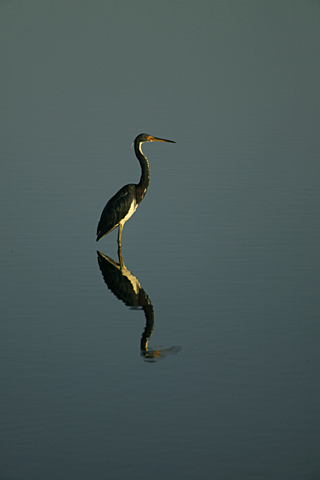
A Tricolored Heron (Family: Ardeidae, Egretta tricolor) You tell these from the rest of the small heron family because a Little Blue Heron doesn't have the white belly and neck stripe and the Green Heron has much shorter legs. Otherwise, those three look similar and are easily confused for one another. |
||
| Here's an Osprey (Family: Pandionidae, Pandion Halieaetus) I spotted feeding next to Bio Lab Road - an 8 mile dirt road you'll be hard pressed to find on a map. It winds through a vast wetland next to Mosquito Lagoon between RT 401 and RT 3. | ||
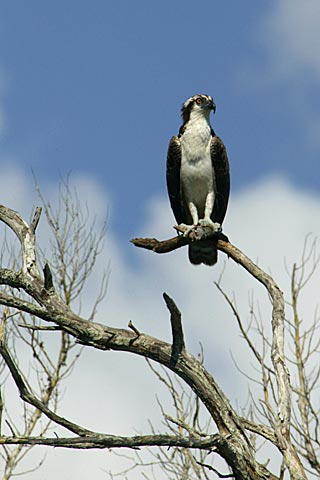 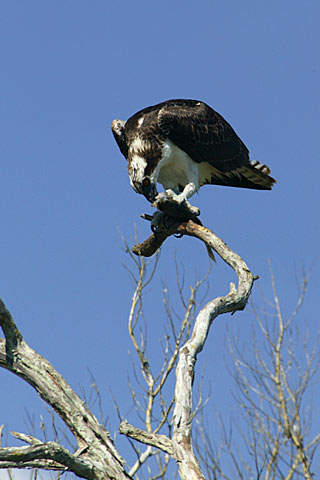 |
||
|
Here's an enlargement showing the
talons on this bad boy (and a partially stripped fish).
The
Osprey is the only raptor that plunges into the water feet first after
it's prey. The Eagle, a distant cousin, skims the water and plucks it's
prey from the surface of the water - it does not plunge into the water. Occasionally, if you're really lucky, you'll see an Eagle dive on an Osprey to scare it and then grab the Osprey's catch before it hits the ground. |
 |
|
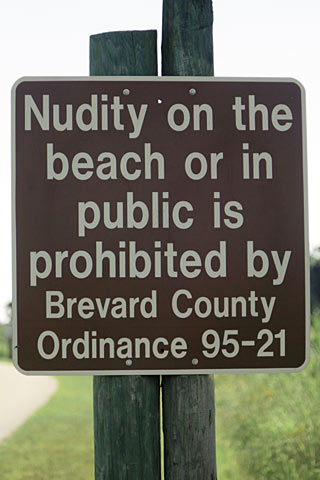 |
Canaveral National Seashore is an
interesting place. It's on a narrow barrier island starting at about
N28° 38.577' W80° 37.490'. Just after you pass through the entrance to
the park, this sign is the first that welcomes you.
There are 11 parking areas on the 5 mile road accessing the length of the beach. Many people on the far reaches of the road ignore the warning. I've no real personal experience here (J), but it appears that the best is from parking lot 9 north to the end -- all pretty remote. This has got to be a cop's dream beat, "So, whatdaya say we go to the beach and check for some 95-21?" |
|
|
On the way back to the farm, I went
shopping in Daytona for a computer for Miranda. I found a couple nice
systems in Best Buy and Circuit City but decided I could do better
on-line. |
||
|
|
| Previous Page | |||
|
Page 5 |
|||